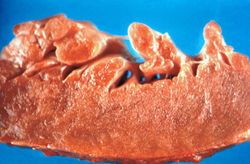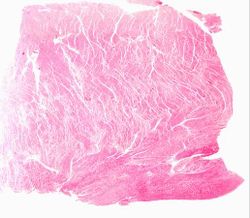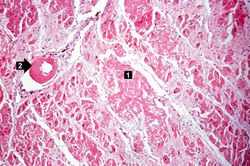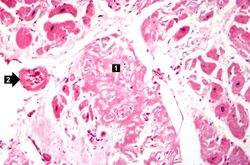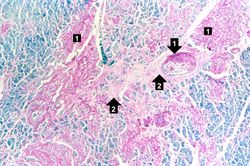Difference between revisions of "IPLab:Lab 6:Senile Amyloidosis"
Seung Park (talk | contribs) |
|||
| Line 13: | Line 13: | ||
File:IPLab6SenileAmyloidosis5.jpg|This is a special stain for amyloid (Luxol PAS) demonstrating the amyloid (1) and fibrosis (2) in the myocardium. The amyloid is darker purple/magenta and tends to be more amorphous. The fibrosis is pink and more fibrillar. | File:IPLab6SenileAmyloidosis5.jpg|This is a special stain for amyloid (Luxol PAS) demonstrating the amyloid (1) and fibrosis (2) in the myocardium. The amyloid is darker purple/magenta and tends to be more amorphous. The fibrosis is pink and more fibrillar. | ||
</gallery> | </gallery> | ||
| + | |||
| + | == Study Questions == | ||
| + | * <spoiler text="What protein makes-up senile amyloid in the ventricle of the heart?">Transthyretin.</spoiler> | ||
| + | * <spoiler text="What protein makes-up senile amyloid in the atrium of the heart?">Atrial natriuretic peptide.</spoiler> | ||
| + | * <spoiler text="At what age does senile amyloidosis usually develop?">Eighth and ninth decades.</spoiler> | ||
| + | * <spoiler text="Where else may senile amyloid deposits occur?">Senile amyloid deposits also occur in the lungs, pancreas, and spleen. Senile cerebral amyloidosis occurs due to deposition of A beta 2 protein in cerebral blood vessels and in senile plaques of Alzheimer's disease patients.</spoiler> | ||
{{IPLab 6}} | {{IPLab 6}} | ||
[[Category: IPLab:Lab 6]] | [[Category: IPLab:Lab 6]] | ||
Revision as of 15:55, 21 August 2013
Clinical Summary[edit]
This 87-year-old black male diabetic was admitted for amputation of the lower extremity involved by atherosclerotic gangrene and osteomyelitis. Following amputation, the patient's course was one of progressive deterioration. Laboratory studies immediately prior to death revealed a blood glucose of 840 mg/dL and a serum CO2 (bicarbonate) of 8.5 mmol/L.
Autopsy Findings[edit]
The heart weighed 540 grams. The endocardial surface of both atria presented a mottled gray-red and gray-white appearance. Multiple sections through the myocardium revealed a marked 'pallor' of the muscle.
Images[edit]
Study Questions[edit]
Osteomyelitis is usually a pyogenic bacteria induced infection/inflammation of bone.
Normal blood glucose levels should be 70 to 100 mg/dL.
A normal bicarbonate level would be 23 to 29 mmol/L (critical level: <10 or >35 mmol/L).
A normal heart weighs 300 grams (range: 270 to 360 grams).
